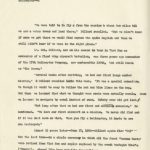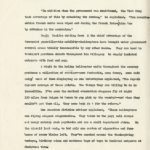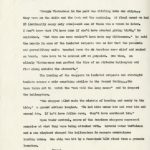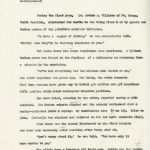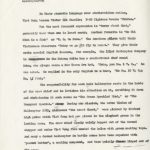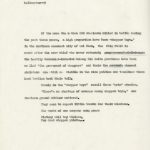1964, December 11, “First American Helicopters Arrived in Vietnam”
deepe
helicopter–1 File HC
RELEASE: DEC. 11, 1964
SAIGON–Three years ago today the first American helicopters arrived in Viet Nam.
The event wa s was historic; they were to become the first helicopters in any war to be used in combat-assault missions. The first 42 H-21 “banana boats” [that?]surprised the sophisticated Saigonese by their capability to fly have seen been seen in the smallest hamlets a nd outposts in the country.
The American pilots who upon their arrival were told to wear sport shirts and slacks to “look like American tourists” have since become a legend.
“The USS Core pulled up i the river and stopped in front of the Ma jestic Hotel at the base of the main street in Saigon,” recalled M Lt. Col. Cahmberlm Robert Dillard, who flew the first helicopter[– –?] off the aircraft carrier. “The streets around the ship were blocked off but thousands of people were backed up for blocks. They had never seen helicopters like ours before and they didn’t think they would fly. But when the choppers did fly, they all applauded like mad.”
deepe
helicopter–2
“We were told to fo fly x from the carrier h about two miles til we saw a water tower and land there,” Dillard recalled. “But we didn’t know if once we got there we would find anyone who spoke English and then we still didn’t know if we were in the right place.”
Lt. Col. Dillard, now on his second tr tour in Viet Nam as commander of a fixed wing aircraft battalion, was three years ago commander of the 57th Helicopter Company, now numberedthe 120th, but still known as “the Deans.”
“Several weeks after arriving, we had our first large combat mission, r Dillard recalled last this week. “It was a special sensation. We thought it would be easy to follow the red and blue lines on the map. But then we learned that what we thought were roads were actually canals. Soon we learned to navigate by canal instead of road. Nobody ever did get lost.“
“Not long after that we had our first sad occasion occasion,” he continued. “We lost our first aircraft on a mission. We never did find out if it was shot down or what. When you fly a helicopter, it hurts to see one destroyed.”
Almost 2 1/2 years later–June 27, 1964–Dillard again flew “049”–for the last time–in a simple ceremony in which all the famed “banana boats” were retired from Viet Nam and replqc replaced by the swank turbojet UH-1’s (“Hueys”), shaped like huge metallic dragonflies.
(More)
deepe
helicopter–3
The rugged increase in the intensity and pace of the war against Communist guerrillas is indexed by the increase in the number and calibre of helicopters. First the The first [two?] H-21 companies were soon to be accompanied by three more plus a Mi Marine helicopter squadron. Later the H-21’s fivexmml companies were of the slow-moving, highly vulnerable H-21’s were replaced by the turbo-ject Hueys and four more Huey companies were added for a total of nine. One third of the Hueys are now armed with r lethal rockets and .30 calibre machineguns.
During the past three years, the anti-Communist struggle here has increasingly been identified as “a helicopter war.” During the The three-years totals, helicopters have carried more than one million passengers and max 40,000 tons of cargo. Of the 22,000 American military personnel Now in Viet Nam, 6,500 belong to bearly nearly 7000 belong to helicopter units. Yet nearly one-third of the this one-third of the personnel ha ve have sustained more than ______ per cent of the battle casualties.
“The helicopter has made the difference between holding our own in the war and failure,” one high-ranking helicopter pilot explained. “The Vietnamese keep asking for more and more helicopter support and we’ve now increased helicopter effectiveness 100 percent.
“The helicopter in a counterinsurgency provides mobility for ground forces they can never achieve in this terrain. T When the Viet Cong (Communist guerrillas) hit a town, by the time the government troops move on the ground, the enemy is gone. The helicopter can move ten times as gast fast.“
deepe
helicopter–4
“In addition when the government was road-bound, the Viet Cong took advantage of this by ambushing the routes,” he explained. “You remember entire French units were wiped out during the French Indo-China War by ambushes int he mountains.”
Basic Besides cutting down d the chief advantage of the Communist guerrilla–his mobility–helicopters have brought under government control areas totally inaccessible by any other means. They are used to transport province chiefs throughout his villages; to supply isolated outposts with food and pay.
A visit to the helicp helicopter units throughout the country produces a collection of stories–some fantastic, some funny, some said said;; most of them displaying as one infantryman explained, “the day-in day-out courage of these pilots. The things they are willing to do is incredible. I’ve seen the medical evacuation choppers fly at night 120 miles from Saigon to Camau to pup pick up the wounded–and when they couldn’t get them all, they came back fo t for the others.”
One American division advisor explained, “These helicopters are flying stageoc stagecoaches. They taken in the pay; sell stamps and money orders; cash paychecks and are a small department store. On the circuit last week, we had only once carton of cigarettes and four boxes of razor blades left. They’ve carried around the Thanksgiving turkeys, birthday cakes and mattress bags of toys to isolated outposts at Christmas time.
(More)
deepe
helicopter–5
A Marine helicopterp pilot of one of the “Flying Wells Fargos” happily recalled “the day a duck got stuck in the radio; we couldn’t get the quack out for a week.”
His buddy, a Marine major, complained, “I don’t like that white flour. One of the bags always breaks open. When the rota blades pick it up, it looks like a white tornado.”
Another chimed in with the inevitable–that “stinking nucc mam,” tge fermented fish sauce the Vietnamese eat with every meal. The pi potent mixture is so aromic the chopper crew chief flies along with his head out the door and has to scrubs down the ship after each flight. (Air Viet Nam–popularly called “Air Nucc Man,” the country’s commercial airline, refuses to carry the little white squat pots of the sauce on their flights. It explodes at high altitude.)
Then the reminisces began. One pilot laughed, “You remember the day we had the airborne cow. We were carrying livestock down Shotgun Alley (a miniature Grand Canyon one-mile long with no exit so the Viet Cong can shoot down rather than up at the choppers.) The crew chief started to control the cow but it ran out the door, turning five sommersaults in the air. We hadn’t issued it a parachute,” he laughed.
“And there was the day the crew chief shoved that American colonel out the door with the Vietnamese ts troops,” he recalled.
One medical evacuation pilot recalled evacuating an outpost while the Viet Cong were moving in only 15 minutes away.
deepe
helicopter–6
“Everys Vietnamese in the post was climbing into our ships… they were on the skids and the dash and the controls. At final count we had 28 (ordinarily carry only nine)–and one of those was a woman in labor. I don’t know what I’d have done if she’d have started giving birth,” he explained. “But then one more wouldn’t have made any difference.” hHe said the morale in some of the isolated outposts was so low that the peasants and paramilitary units knocked down the ak American crew chief and rushed on board. Some have to be ordered off at gunpoint. One time, an elderly Vietnamese man grabbed the tire of an airborne helicopter and flew along outside the aircraft.“
The landing of the choppers in isolated outposts and strategic hamlets causes a stir something similar to the Second Coming… the town turns out to watch the “men with the long noses” and to inspect the helicopters.
“One chopper pilot made the mistake of handing out candy to the kids,” a ground advisor laughed. “He had kids under him and over him and around him. If he’d have fallen down, they’d have smothered him.”
Upon their arrival, crews of the American choppers expressed surprise at what they were being attacked with. Several water buffaloes and c one elephant charged the helicopters in maounta mountainous landing zones. One ship was hit by a four-inch bold fired from a grenade launcher.
(More)
deepe
helicopter–7
During the first year, Lt. Arthur A. Williams of Ft. Bragg, North Carolina, maintained for months he was being fired h at by spears and bamboo arrows of the primitive mountain tribesmen.
“Go have a couple of drinks,” he was consistently told. “Pretty soon they’ll be throwing elephants at you.”
But weeks later his suspe suspicions were confirmed. A 15-inch bamboo arrow was lodged in the fuselage of a helicopter ru returning from a mission in the mountains.
“We’ve had everything but the kitchen sink thrown at us,” one pilot explained two years ago. But today, the crude homemade Viet Cong weapons have given way to lethal .50 calibre and .57 recoiless rifle gunfire which makes helicopter missions perilous.
One crew chief, swearing he was sober, reported seeing a pink elephant. His Marine cohorts alughedlaughed and the company cartooneist drew a curley-eyelashed Dumbo r saying: My coordinates are: YT zz 345. Color me pink. (Actually the elephant had wallowed in the red mouta mountain clay).
Then there was the second lieutenant on his first mission who came back nervously swear sweating after being shot at.
“Don’t worry about it,” he was told. “You have only 11 more months to go.”
The pilots have a language all their own. Seldom are the worlds words “yes” or “no” used. “Roggg” or “that’s affirmative” or “negative” are used by them all, each pronounced with the slowness of a sleepy Southerner.
deepe
helicopter–8
In their phonetic language over static-ridden radios, Viet Cong become Victor Cah Charlie; B-26 fighters become “Bravos.”
But the most frequent expression is “Sorry about that,” generally used when one is least sorry. Another favorite is “Ho Chi Minh is a fink” or “V. C. Go Home.” The American pilots tell their Vietnamese observers “Today we go flt fly to Hanoi.” They give their cooks special English lessons, for example, the 121st Helicopter Company in Sonimaismm in the Mekong delta has a small-framed chef named Duke who always wears a New Years Eve hat. “Duke, you No. 1 V.C.,” he was asked. He replied in the only English he knew, “Me No. 10 V.C.; No 1. fink.”
The responsibility for each helc helicopter rests in the hands of the crew chief and he lavishes his attention on it, scrubbing it down and christening it such names as “The Green Speckled Bird,” or “The Boneyard Special.” Many During one mission, the rotor blades of Helicopter 2085, nicknamed “the Great Ghost,” were pierced by 12-foot high poles which Viet Cong had pca placed in the elephant grass in the landing zone. The crew chief clamly calmly hopped out of the downed chopper and under Viet Cong fire mended the holes with green masking tape. And many a downed helicopter in battle zones have been repaired with “peanut butter”, a sealing compound, and then quickly flown limped out of the area.
deepe
helicopter–9
Of the more tha n than 200 Americans killed in battle during the past three years, a high proportion have been “chopper boys.” In the northern seacoast city of Qui Nhon, the file field is named after the crew chief who never returned; gray are aklengm the heavily Communist-infested Mekong Dle Delta provinces have been ca lled “the graveyard of choppers” and their the smoked charred skeletons are still se visible in the rice paddies and treelines where hard battles took their toll.
Rarely do the “chopper boys” recall these “grim” stories.
“There’s no shortage of courage among chopper boys,” one American ground advisor muttered.
They seem to expect little thanks for their missions.
The words of one company song goes:
History will buy violets,
For dead chopper pilots…
Read Previous Article: 1964, December 8, “Escalation of the War”
Read Next Article: 1964, December 17, “Communist-led Buddhist Movement”


